
It is estimated that over 721 million people worldwide live on $1.90 per day or less — the extreme poverty threshold set by the World Bank. While this is an improvement from years past, that is still more than 9% of the world’s total population.
This type of poverty tends to concentrate in certain areas with relatively low incomes. Gross national income, or GNI, is the sum of money earned by a country’s population and businesses within a given year. It includes income earned by corporations or persons based in a given country but operating outside of its borders. GNI is a useful measure for determining the overall income of a country. The measure helps indicate which countries are the richest and the poorest in the world.
To determine the poorest countries in the world, 24/7 Wall St. reviewed data on gross national income per capita for 193 countries and special regions with available data from the World Bank.
The nearly 7.8 billion people in the world earned $134.6 trillion in income in 2019, the most recent year for which there is data. This breaks down to a worldwide GNI per capita of $17,535. The U.S. ranks 10th in the world, with a GNI per capita of $66,060. On the other end, 27 countries have a GNI per capita of less than $3,000, including two countries that had an annual GNI of less than $1,000 per person.
Nearly all of the poorest countries in the world are located in Africa. The continent has long struggled with violent conflicts and political instability. Harvard University researchers Daron Acemoglu and James A. Robinson wrote in a paper on poverty in Africa that the continent struggles economically because “property rights are insecure and very inefficiently organized, markets do not function well, states are weak, and political systems do not provide public goods.” They added that these “dysfunctional dynamics were then further reinforced by colonialism” when other countries extracted resources from Africa.
Even though some of these African countries have enough natural resources like oil and gold to lift incomes, much of the wealth goes to a select few at the top of the political system, leaving large percentages of the population in poverty. These are the countries with the widest gaps between rich and poor.
Click here to see the world’s 27 poorest countries.
To determine the poorest countries in the world, 24/7 Wall St. reviewed data on gross national income per capita for 193 countries and special regions with available data from the World Bank. The World Bank estimates GNI per capita using the purchasing power parity method, and figures are in current international dollars. All data on GNI per capita is based on the most recent available year for a given country.
Additional data on GDP in current U.S. dollars, population, life expectancy at birth, and access to electricity also came from the World Bank. All data is for the most recent year available for every country.
We also considered data on public sector corruption in 2020 from the nonprofit, international watchdog and anti-corruption group, Transparency International.
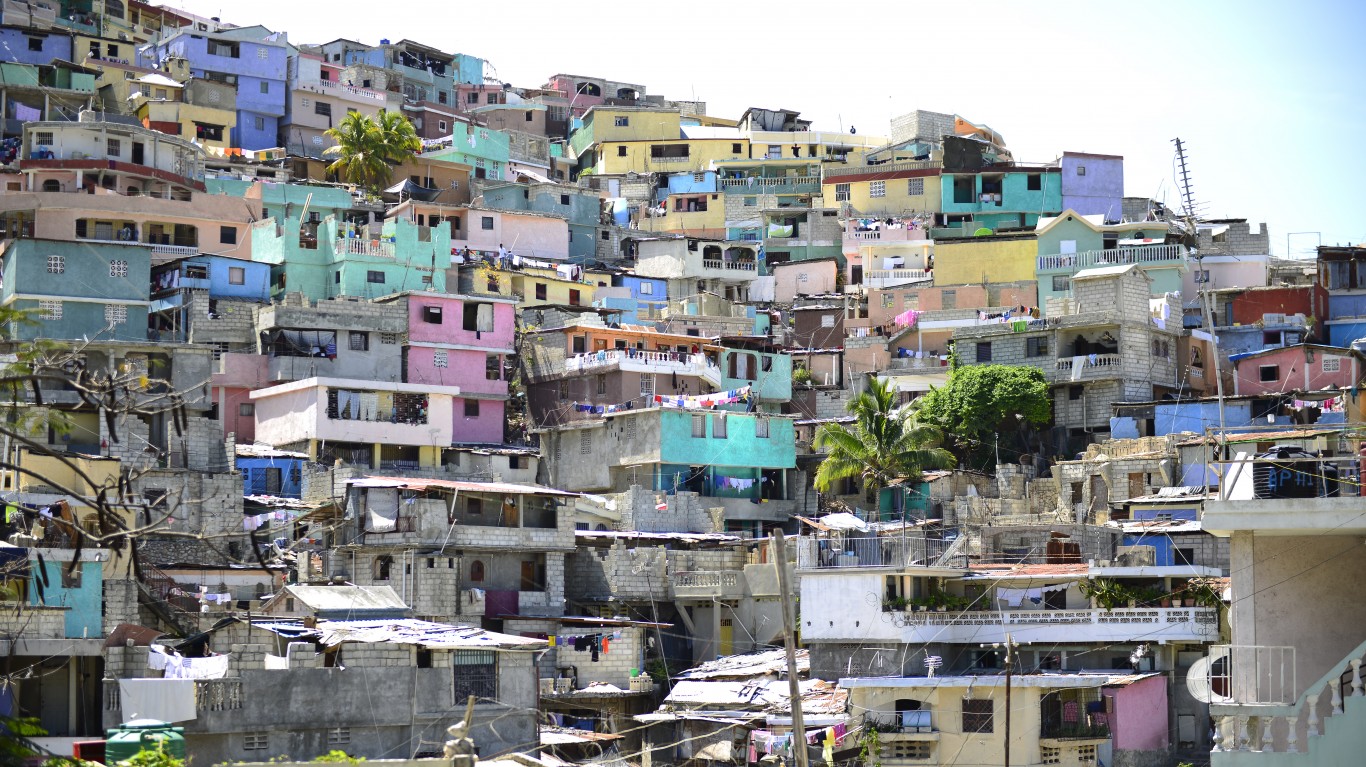
27. Haiti
> GNI per capita: $2,930
> 2020 GDP: $13.4 billion
> Life expectancy: 64.0 years
> Population: 11.4 million
Haiti is one of just 27 countries in the world in which the gross national income per capita is less than $3,000. A country’s GNI includes its total GDP as well as the net income generated by a country’s residents earned outside its national borders. The GNI per capita worldwide is $17,535. The U.S. GNI per capita is just over $66,000 and is the 10th highest in the world.
Like in many other economically disadvantaged countries, many Haitians lack access to power and health care. Less than half of Haiti’s 11.4 million residents have access to electricity, and the country’s 14.5% unemployment rate is more than double the worldwide rate of 6.5%, per the World Bank. Haiti is also struggling with political instability. President Jovenel Moïse was assassinated at his home on July 7, and Haiti ranks as one of the most corrupt countries in the world by Transparency International.
[in-text-ad]
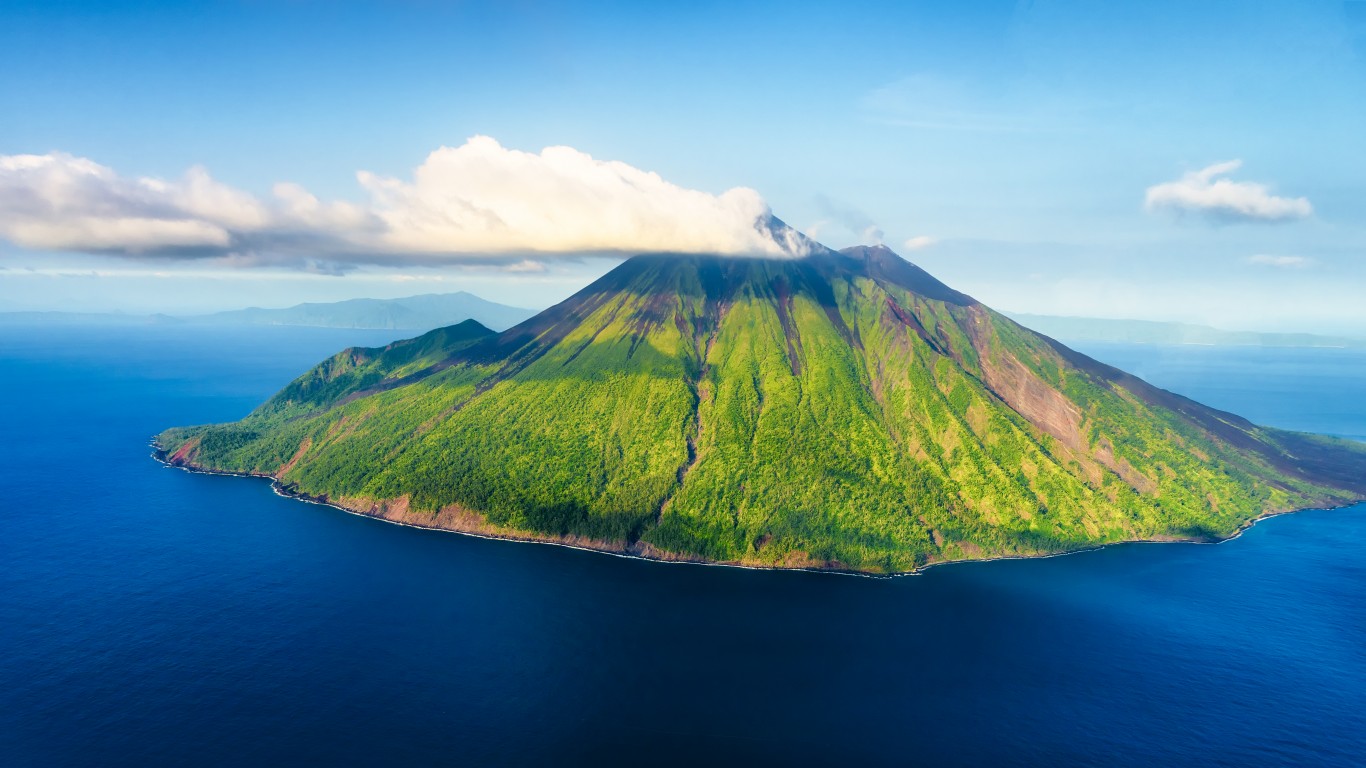
26. Vanuatu
> GNI per capita: $2,880
> 2020 GDP: $854.8 million
> Life expectancy: 70.5 years
> Population: 307,150
The nation of Vanuatu is made up of dozens of islands northeast of Australia. Vanuatu’s GNI per capita is just $2,880, one of the lowest in the world. It is also one of just 15 countries that had a total GDP of less than $1 billion in 2020. Most of these countries, like Vanuatu, are relatively small island nations.
Though the country has little economic activity, Vanuatu’s citizens do not have the same health struggles that are common in many other nations on this list. The mortality rate for children under 5 in Vanuatu is 25.9 per 1,000 live births, lower than the worldwide average of 37.7 per 1,000 live births. The maternal mortality rate in the country is also roughly one third of the worldwide rate.
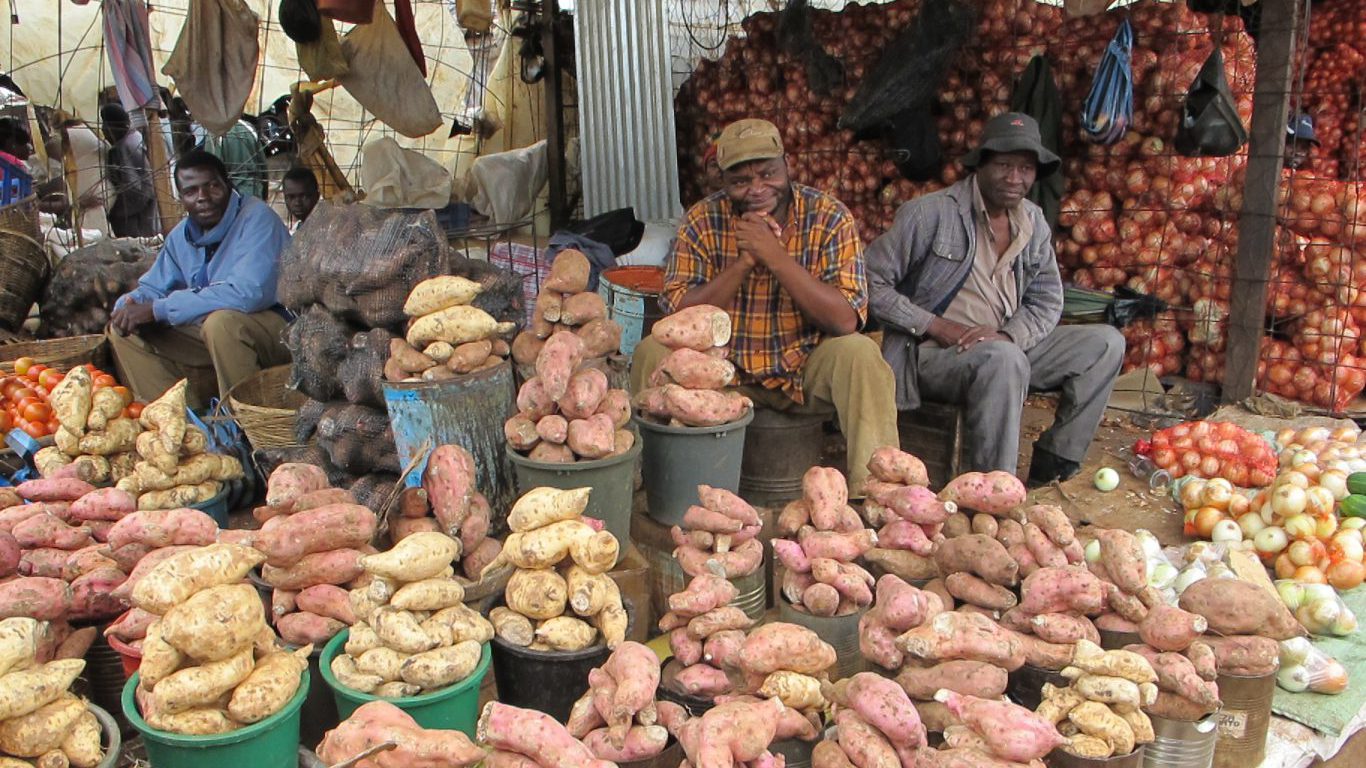
25. Zimbabwe
> GNI per capita: $2,850
> 2020 GDP: $16.8 billion
> Life expectancy: 61.5 years
> Population: 14.9 million
Zimbabwe has the 25th lowest GNI per capita in the world — the country produced $2,850 of income per person in 2020. One of Zimbabwe’s major economic issues is severe income inequality. It has one of the world’s largest gaps between high- and low-income earners, according to World Bank data. Economic inequality can stifle growth by making it difficult for people to get the skills and education needed to break the cycle of poverty.
In addition to a lack of infrastructure, low incomes can make it difficult for Zimbabwe residents to access crucial services like health care or power. Just 41.4% of the population has access to electricity, and the country’s child and maternal mortality rates are much higher than typical.

24. Tanzania
> GNI per capita: $2,760
> 2020 GDP: $62.4 billion
> Life expectancy: 65.5 years
> Population: 59.7 million
Tanzania’s GNI per capita of $2,760 is one of the lowest in the world, with a high share of its residents living in extreme poverty. Nearly half of all residents live on $1.90 per day or less, the sixth highest share of any country. Worldwide, 9.3% of people live at that income level.
Like every other country on this list for which there is data, an outsized share of Tanzania’s GDP, 26.7%, comes from agriculture, forestry, and fishing. Worldwide, 3.5% of overall economic output comes from agriculture and related professions. Wealthy nations tend to have diversified economies, whereas poorer countries tend to rely heavily on these jobs. Nearly two-thirds of the country’s poor working adults made a living through agriculture.
[in-text-ad-2]
23. Lesotho
> GNI per capita: $2,740
> 2020 GDP: $1.8 billion
> Life expectancy: 54.3 years
> Population: 2.1 million
Lesotho is one of 23 African nations to rank among the 27 poorest countries in the world. The country is entirely surrounded by South Africa and has a GNI per capita of $2,740. This low income is at least partially explained by the nation’s high unemployment rate of 24.7% — the third highest jobless rate among all countries.
As is the case in many relatively poor countries, people in Lesotho may struggle to afford basic health care. The country has a life expectancy of just 54.3 years, which is nearly two decades lower than the 72.7-year average life expectancy worldwide.
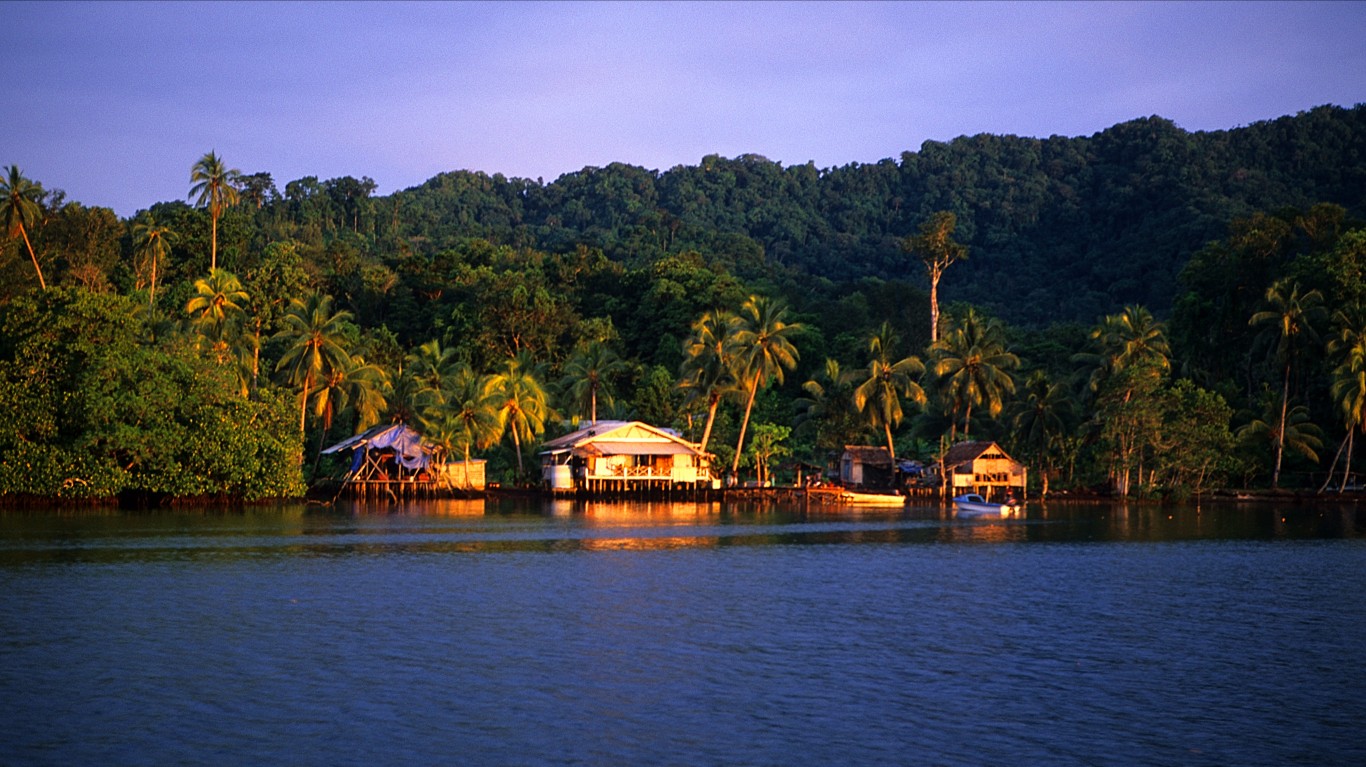
22. Solomon Islands
> GNI per capita: $2,680
> 2020 GDP: $1.6 billion
> Life expectancy: 73.0 years
> Population: 686,878
The Solomon Islands is a country made up of hundreds of islands in the Coral Sea just east of Papua New Guinea and northeast of Australia. It has the lowest GNI per capita of any country outside of Africa or the Middle East, at $2,680. For context, the U.S. GNI per capita is just over $66,000.
In spite of its low GNI per capita, Solomon Islands residents are less likely to struggle with the economic and health issues commonly found in other countries on this list. For instance, the country’s life expectancy of 73 years is actually slightly higher than is typical worldwide. The maternal and child mortality rates are roughly half of the worldwide rates.
[in-text-ad]

21. Guinea
> GNI per capita: $2,580
> 2020 GDP: $15.7 billion
> Life expectancy: 61.6 years
> Population: 13.1 million
Exports of goods and services tend to account for a large share of wealthier nations’ GDPs, whereas agriculture makes up a large share of the economic outputs of less wealthy countries. Guinea is the only country to rank among the world’s poorest with exports accounting for over 50% of its 2020 GDP. The vast majority of Guinea’s exports are aluminum ore and gold. Yet the country still has a GNI per capita of $2,580, lower than all but 20 other nations.
Even compared to other countries on this list, Guinea has especially dire health outcomes. Its mortality rate of children under 5 is 98.8 deaths per 1,000 live births, the sixth highest rate in the world and well more than double the worldwide average child mortality rate. Guinea’s maternal mortality rate of 576 maternal deaths per 100,000 live births is also well more than double the worldwide rate.

20. Ethiopia
> GNI per capita: $2,410
> 2020 GDP: $107.6 billion
> Life expectancy: 66.6 years
> Population: 115.0 million
Ethiopia is one of just 20 countries with a GNI per capita of less than $2,500. With nearly 115 million people, it is by far the largest country to rank among the world’s poorest. Agriculture workers tend to have low incomes, and 35.5% of Ethiopia’s GDP comes from agriculture, forestry, and fishing — a share that is 10 times higher than the industry’s share in the total economic output of all countries.
Ethiopia’s economy has struggled with drought conditions in 2020, as well as years of violent political instability. Prime Minister Abiy Ahmed won the Nobel Peace Prize for negotiating an end to the war with neighboring Eritrea in 2019. Yet in 2020, Ahmed launched attacks against rebel fighters in the Tigray region in the northern part of the country after the area held its own elections in defiance of Ethiopia’s government. Thousands have died in the fighting.

19. Uganda
> GNI per capita: $2,260
> 2020 GDP: $37.4 billion
> Life expectancy: 63.4 years
> Population: 45.7 million
Uganda is a landlocked country in eastern Africa. Like many of the countries in the area, it has relatively low incomes. THe country’s GNI per capita is just $2,260 — a fraction of the worldwide GNI per capita of roughly $17,500.
The poorest countries in the world tend to have large shares of their population living in rural areas, and Uganda is no exception. As many as 75% of Ugandans live outside of large population centers — and more than 41% of Uganda residents live on $1.90 per day or less.
[in-text-ad-2]
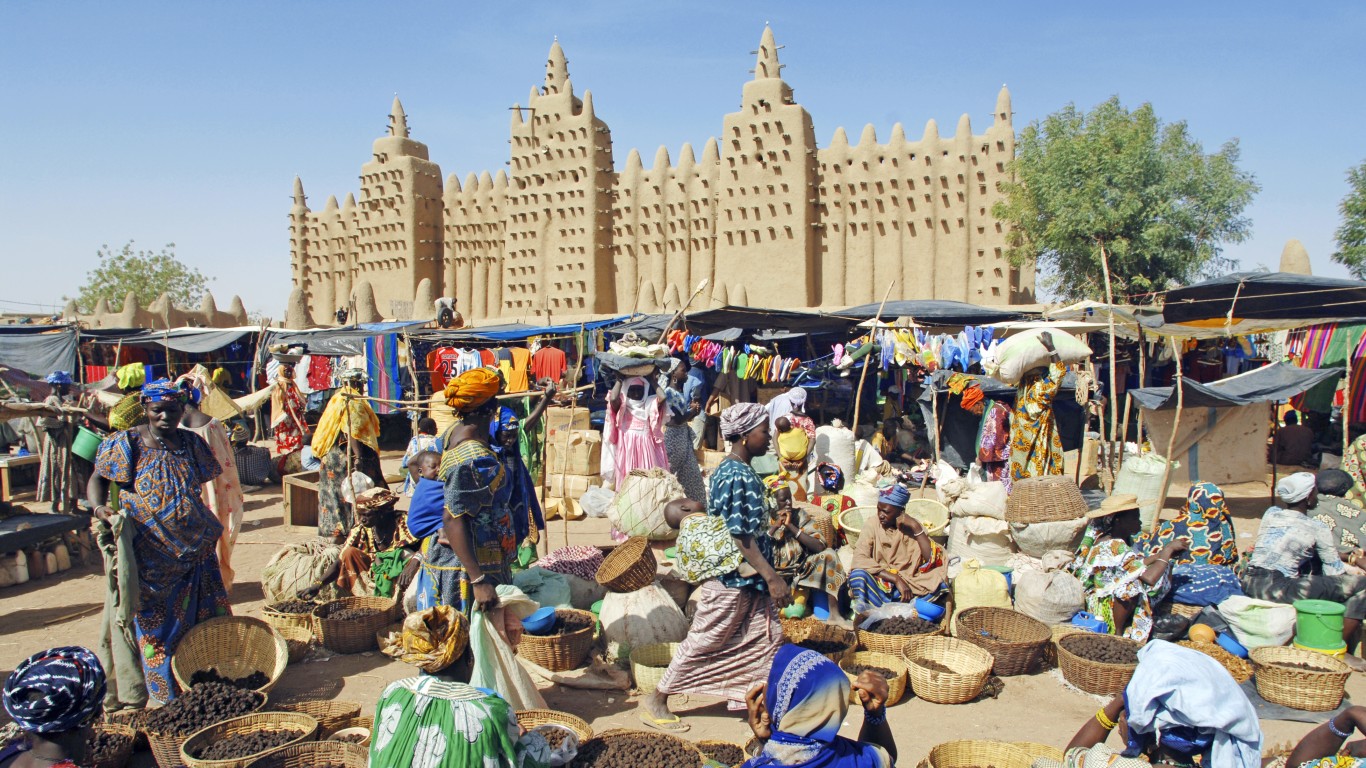
18. Mali
> GNI per capita: $2,250
> 2020 GDP: $17.4 billion
> Life expectancy: 59.3 years
> Population: 20.3 million
Mali is one of the poorest countries in the world, with a GNI per capita of $2,250. Worldwide, the per capita economic output is $17,535. Low-income countries often have reduced access to health care, and Mali has a life expectancy at birth of 59.3 years, more than 13 years lower than the worldwide life expectancy.
A number of factors make socioeconomic conditions difficult in Mali, including education. Just 35.5% of people 15 and older in the country are literate, the fourth lowest rate among all countries for which there is data. Worldwide, 86.5% of adults 15 and older can read. Also, less than half of all Malians have access to electricity, compared to over 90% of all people in the world.
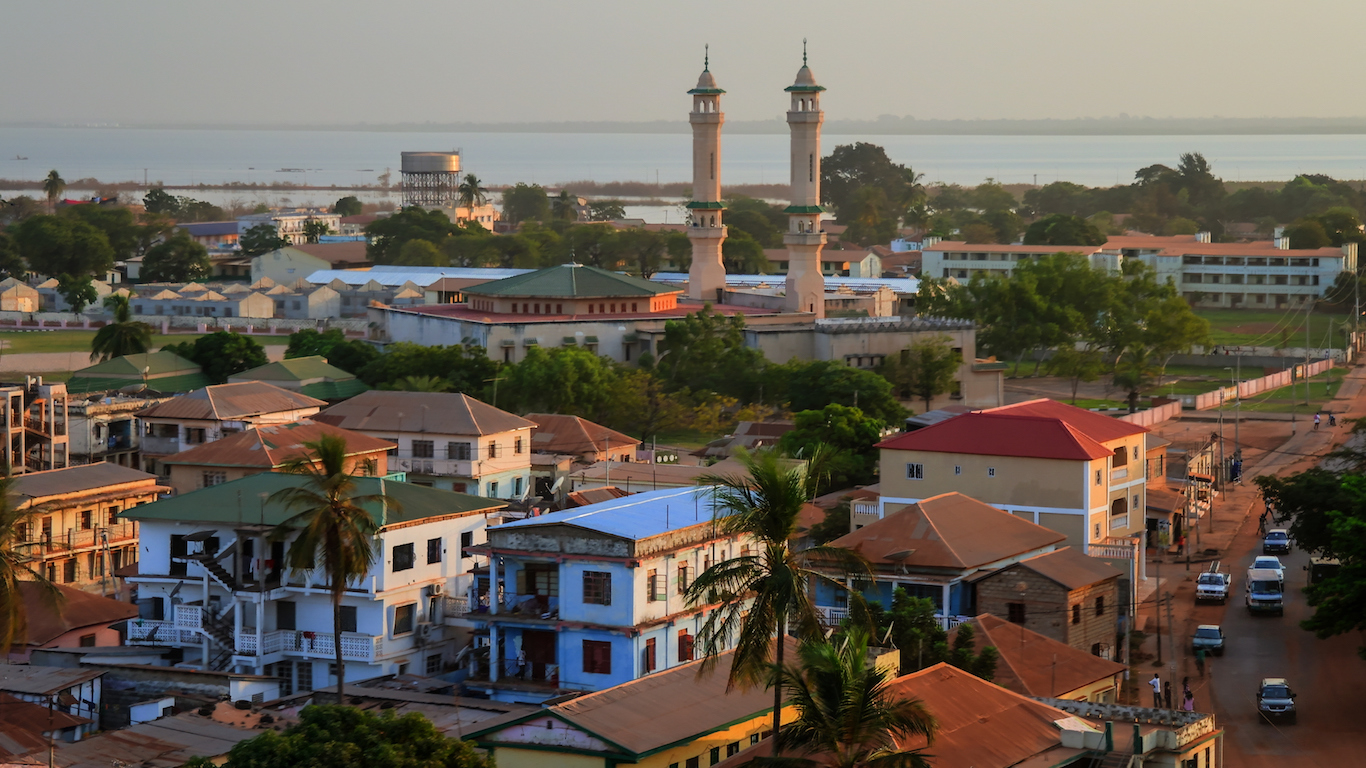
17. The Gambia
> GNI per capita: $2,240
> 2020 GDP: $1.9 billion
> Life expectancy: 62.0 years
> Population: 2.4 million
The Gambia has a gross national income per capita of $2,240, accounting for all economic activity in the country as well as income of Gambians generated outside of the country. The country’s 9.6% unemployment rate is well above the 6.5% rate worldwide.
In most of the world’s poorest countries, the majority of residents live in rural areas and agriculture makes up a relatively large share of economic activity. Yet in The Gambia, just 37.4% of the population live in rural areas, compared to 43.8% of the world’s population. In spite of the country’s fairly urban makeup, less than 60% of people in The Gambia have access to electricity.
[in-text-ad]
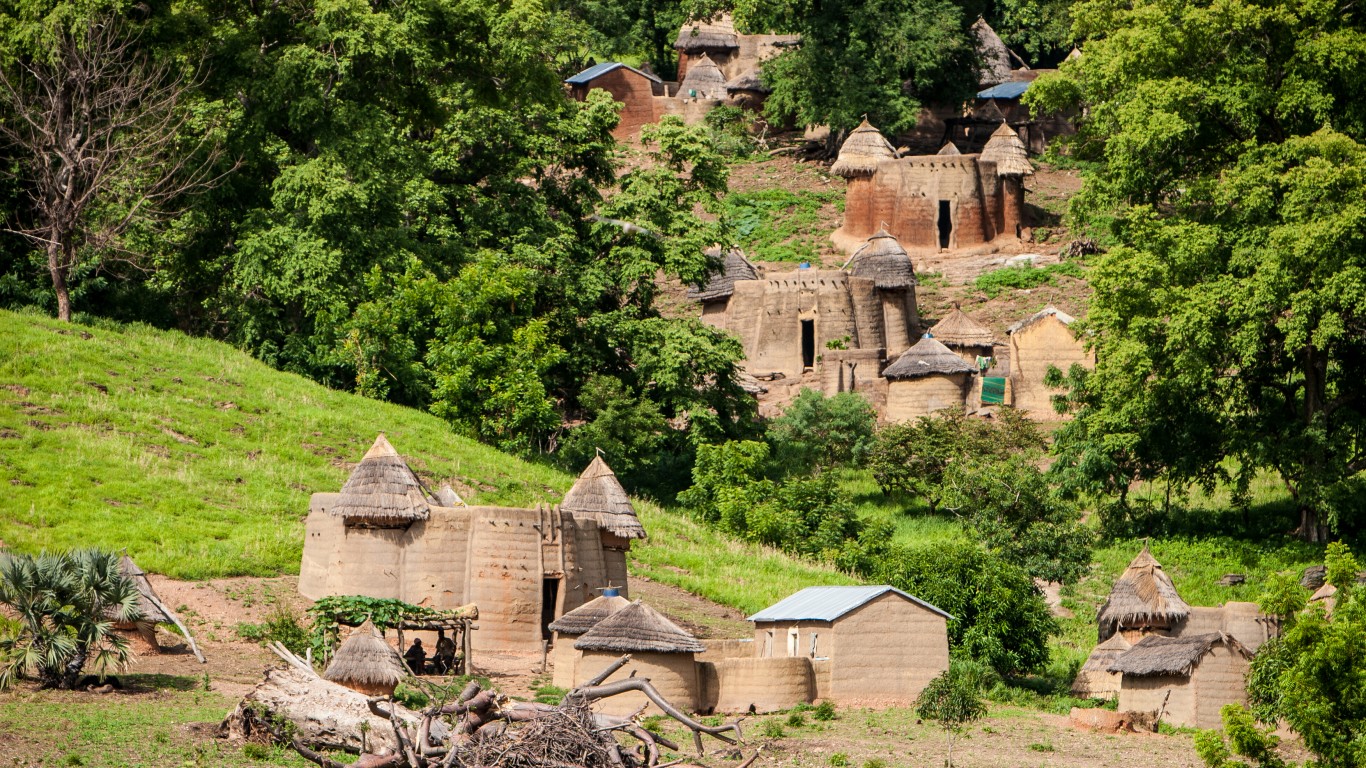
16. Togo
> GNI per capita: $2,230
> 2020 GDP: $7.6 billion
> Life expectancy: 61.0 years
> Population: 8.3 million
Togo has a GNI per capita of $2,230, lower than all but 15 other countries in the world, out of nearly 200 nations. Over 57% of the country’s population live in rural areas, which can make it difficult to obtain education and health care.
Like nearly every other country on this list, health outcomes are relatively poor in Togo. Low-income populations often struggle to get adequate health care or nutrition. Togo has a life expectancy at birth of 61 years — over a full decade lower than the average worldwide. Maternal and child mortality are much more common in Togo than they are in most countries.
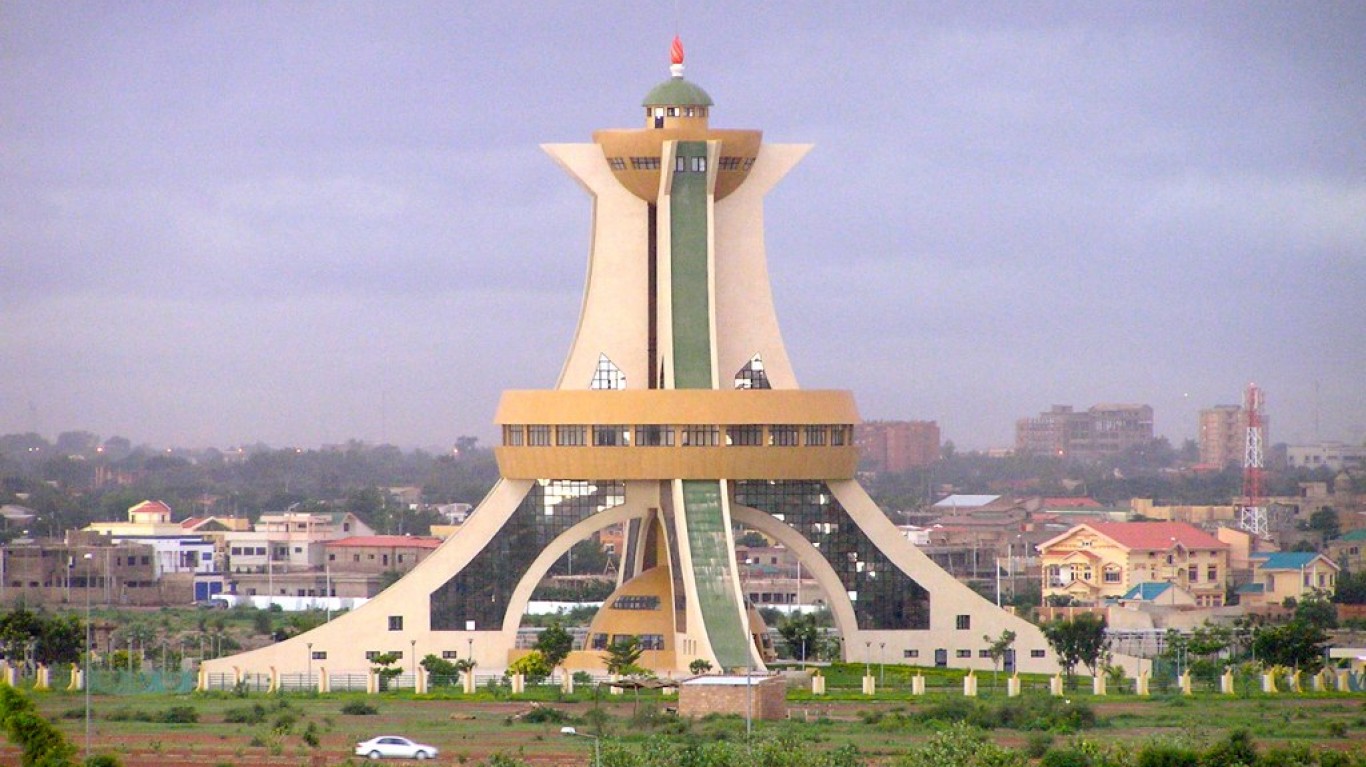
15. Burkina Faso
> GNI per capita: $2,190
> 2020 GDP: $17.4 billion
> Life expectancy: 61.6 years
> Population: 20.9 million
Burkina Faso is a landlocked country in West Africa that shares a border with several other countries on this list, including Mali, Niger, and Togo. One of the poorest countries in the world, over 41% of Burkina Faso residents live below the national poverty line.
More than a quarter of Burkina Faso’s GDP comes from exporting goods and services — lower than the 29.5% average worldwide but still higher than most other countries ranking among the world’s poorest. The vast majority of the country’s exports are in gold, worth $4.6 billion out of the nation’s $6 billion in total exports in 2019.
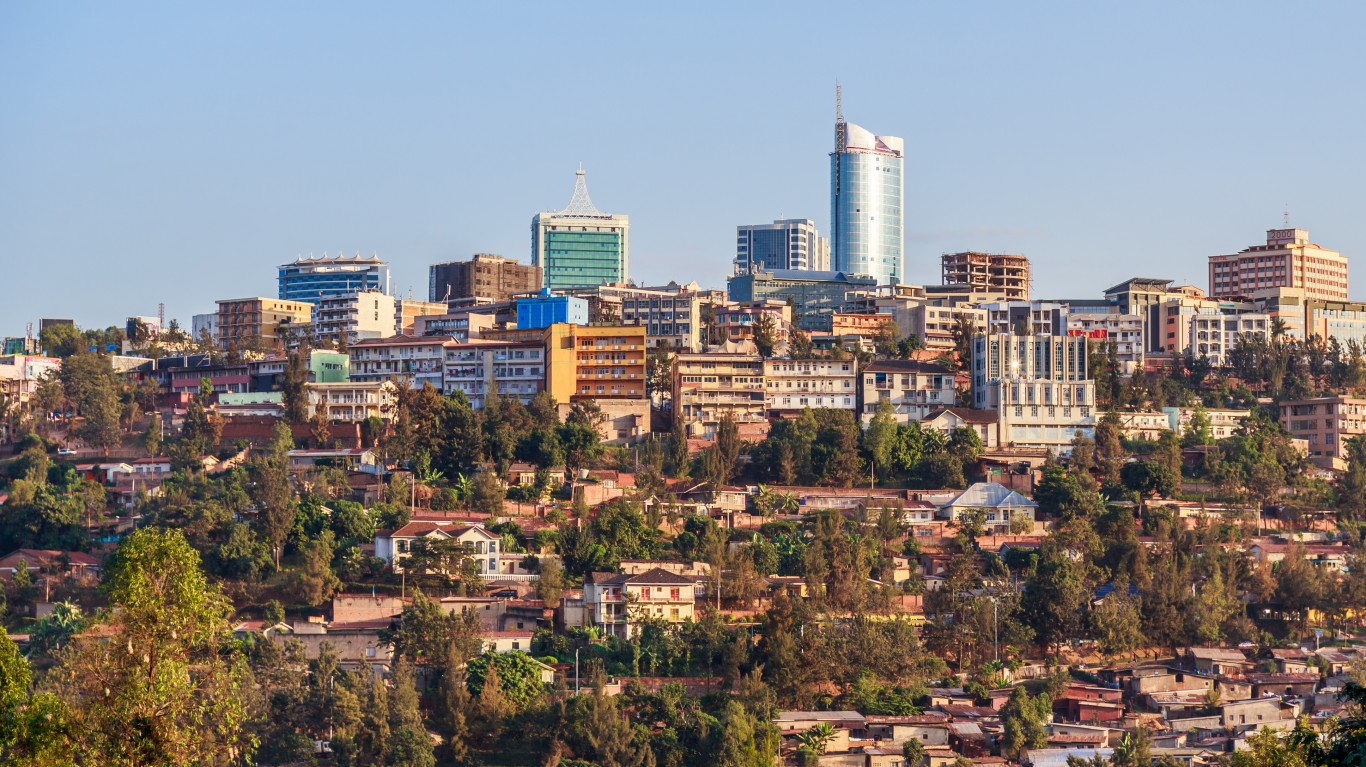
14. Rwanda
> GNI per capita: $2,160
> 2020 GDP: $10.3 billion
> Life expectancy: 69.0 years
> Population: 13.0 million
Rwanda is one of the poorest countries in the world, with a GNI per capita of $2,160 — a fraction of the worldwide GNI per capita of $17,535. More than half of Rwandans live in extreme poverty. More than half of Rwandans, 56.5%, live in extreme poverty, defined as living on $1.90 per day or less — the fourth highest share among all nations for which there is data.
In spite of the rampant poverty, Rwanda has some advantages over other nations that rank among the world’s poorest. Of all countries on this list, its institutions are seen as the least corrupt, according to Transparency International. Rwanda’s life expectancy at birth of 69.0 years is relatively close to the worldwide average life expectancy of 72.7 years, and its child mortality rate of 34.3 per 1,000 live births is actually better than the worldwide rate of 37.7 per 1,000 live births.
[in-text-ad-2]
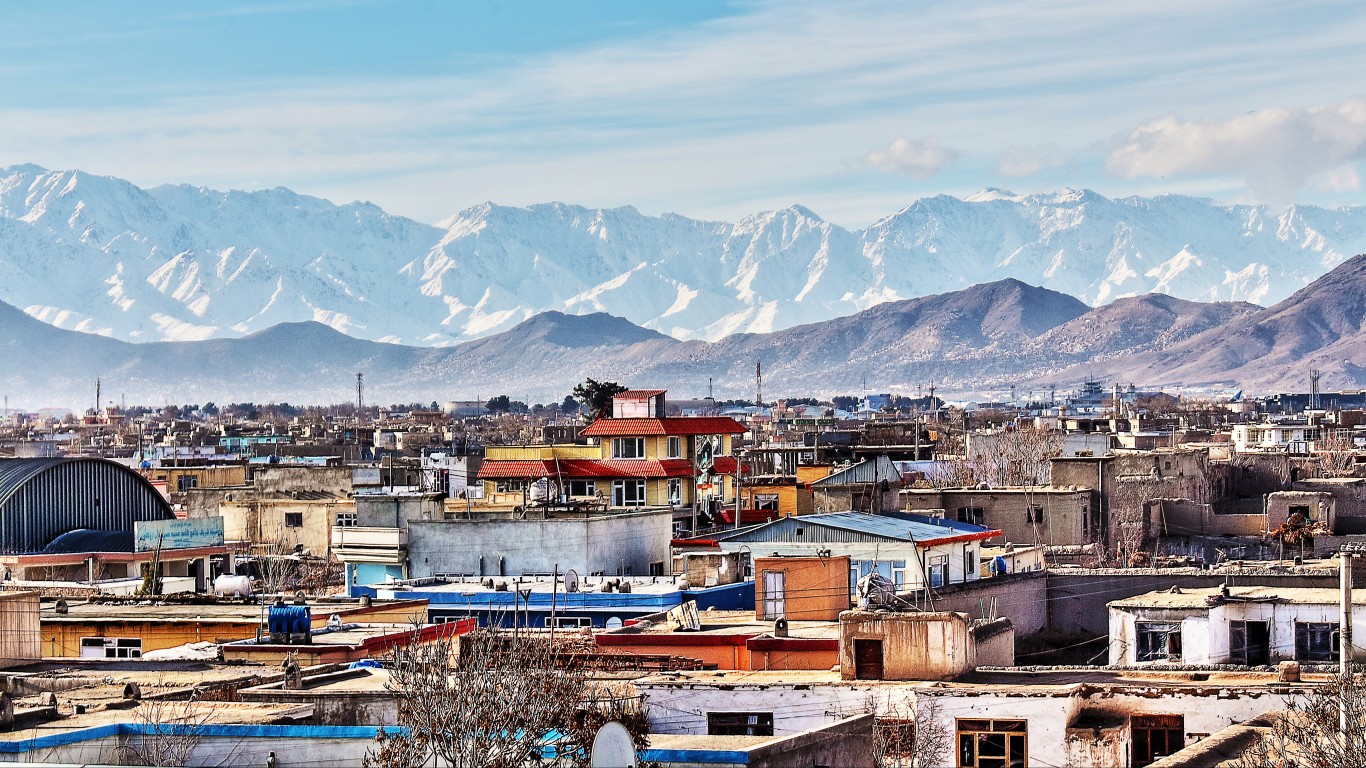
13. Afghanistan
> GNI per capita: $2,110
> 2020 GDP: $19.8 billion
> Life expectancy: 64.8 years
> Population: 38.9 million
Afghanistan is the only Middle Eastern country to rank among the world’s poorest. Nearly all of the other poorest countries are either in Africa or are relatively small island nations. Only a dozen countries have a lower GNI per capita than Afghanistan’s GNI per capita of $2,110.
War and violence stifle economic growth, and Afghanistan has faced constant turmoil and adversity. Since the Sept. 11 terrorist attacks, the U.S. has waged a long-standing war in the country. Over 240,000 people have been killed in the Afghanistan and Pakistan war zone since 2001, including more than 71,000 civilians. American troops are rapidly pulling out of the country, aiming to completely leave by August of 2021.
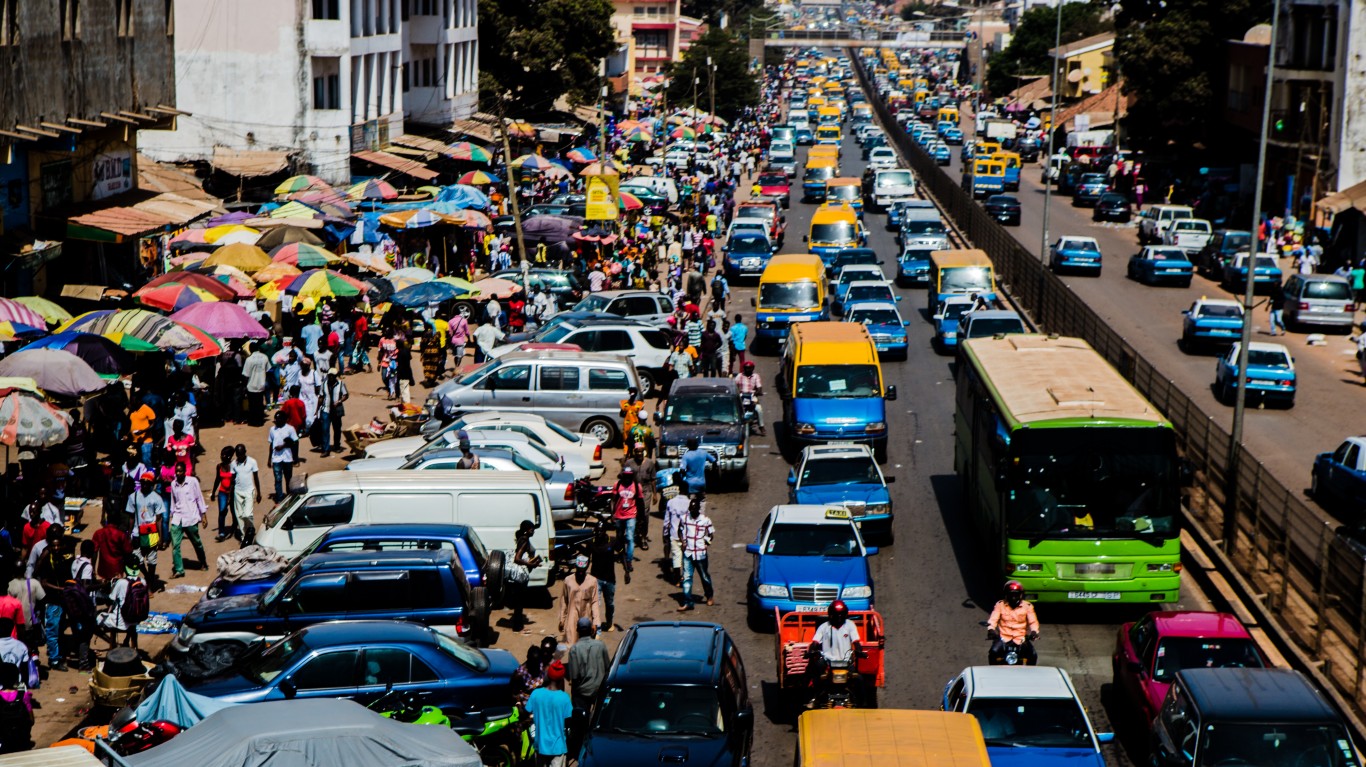
12. Guinea-Bissau
> GNI per capita: $1,980
> 2020 GDP: $1.4 billion
> Life expectancy: 58.3 years
> Population: 2.0 million
Guinea-Bissau is one of just a dozen countries in which the gross national income per capita is less than $2,000. Worldwide, the GNI per capita is $17,535. Lower incomes often lead to health care challenges, and in Guinea-Bissau, child mortality, maternal mortality, and tuberculosis diagnoses are all more than twice as common compared to worldwide rates.
Wealthier countries generally have a much higher share of their economic activity attributed to exports, while poorer countries rely more heavily on agriculture and related professions. Guinea-Bissau had less than $250 million worth of exports in 2019, most of which were crops like coconuts, cashews, and brazil nuts.
[in-text-ad]
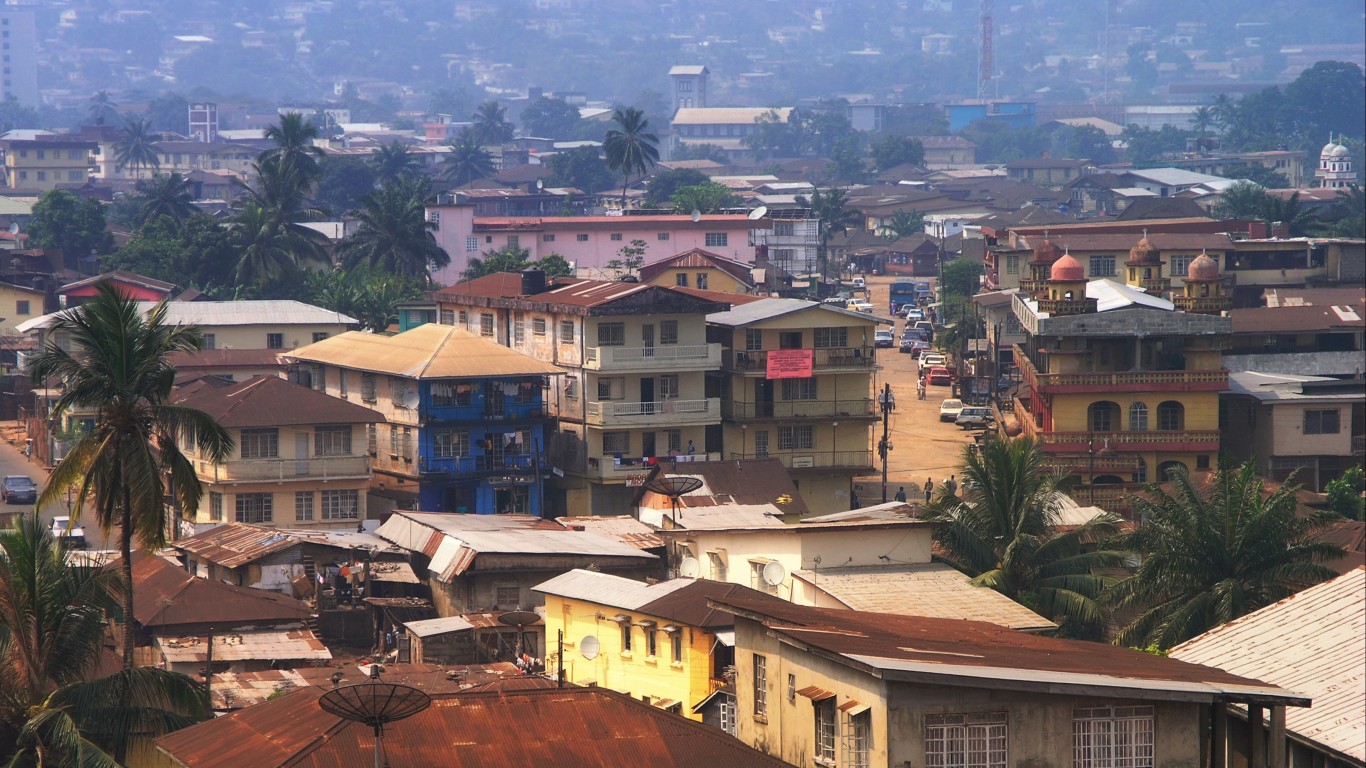
11. Sierra Leone
> GNI per capita: $1,670
> 2020 GDP: $3.9 billion
> Life expectancy: 54.7 years
> Population: 8.0 million
Sierra Leone on Africa’s western coast has a GNI per capita of $1,670, which is lower than all but 10 other countries in the world. This level of poverty has had a devastating effect on the population — Sierra Leone is one of just four countries in which the life expectancy at birth is less than 55 years.
Wealthy countries tend to have diversified economies and often derive much of their economic output from exports, whereas the workers in poorer countries tend to work as farmers. Sierra Leone is the only country on Earth that gets the majority of its GDP — 61.3% — from agriculture, forestry, and fishing. Sierra Leone is actually rich in resources like diamonds, titanium ore, bauxite, iron ore, and gold, but the country has faced a string of related violent conflicts that have destabilized the country.
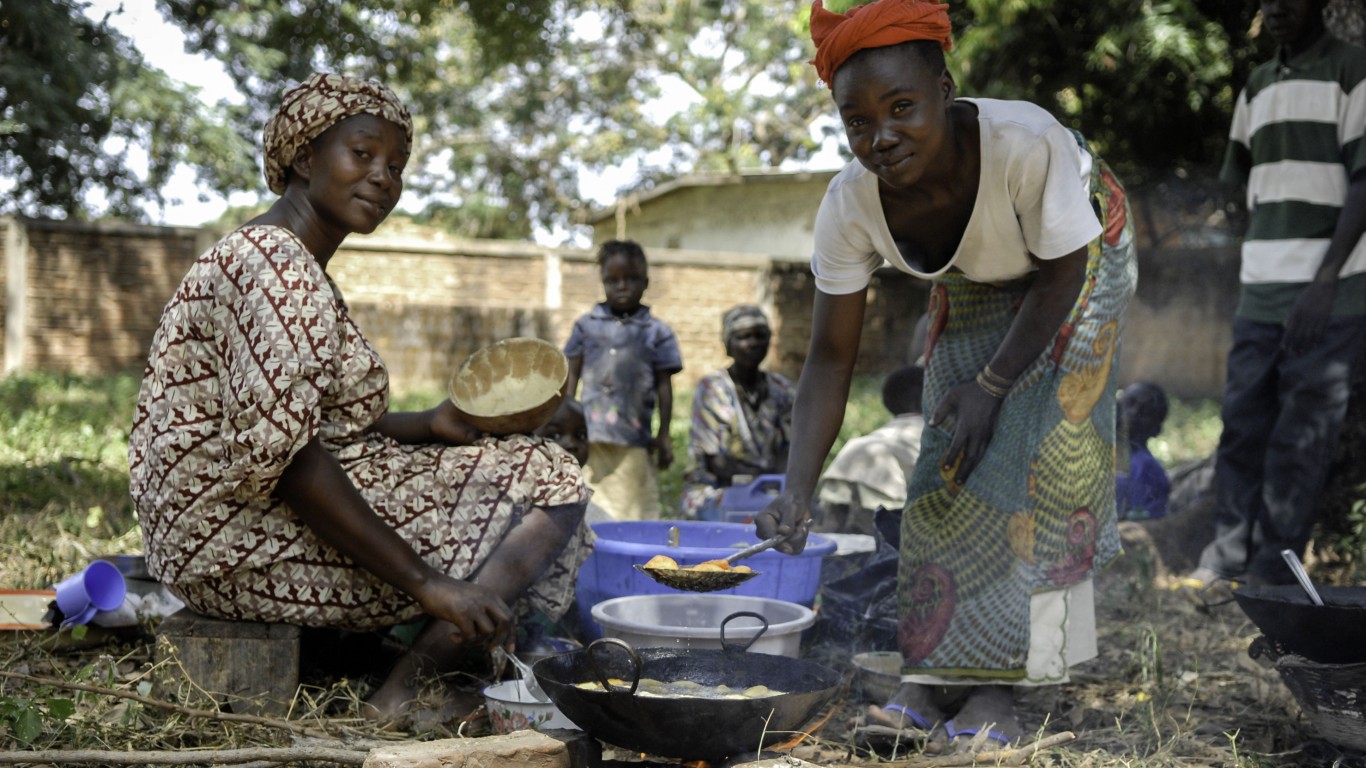
10. Chad
> GNI per capita: $1,580
> 2020 GDP: $10.1 billion
> Life expectancy: 54.2 years
> Population: 16.4 million
Chad is one of the 10 poorest countries in the world, with a GNI per capita of $1,580. This is less than a 10th of the worldwide GNI per capita. Low-income countries like Chad often face severe health challenges because of a lack of money and resources.
Chad is one of just two countries, along with South Sudan, in which less than 10% of residents have access to electricity. This can make it difficult to administer health care. Chad is one of just three countries with a maternal mortality rate higher than 1,000 deaths per 100,000 live births. The worldwide maternal mortality rate is 211 maternal deaths per 100,000 live births.
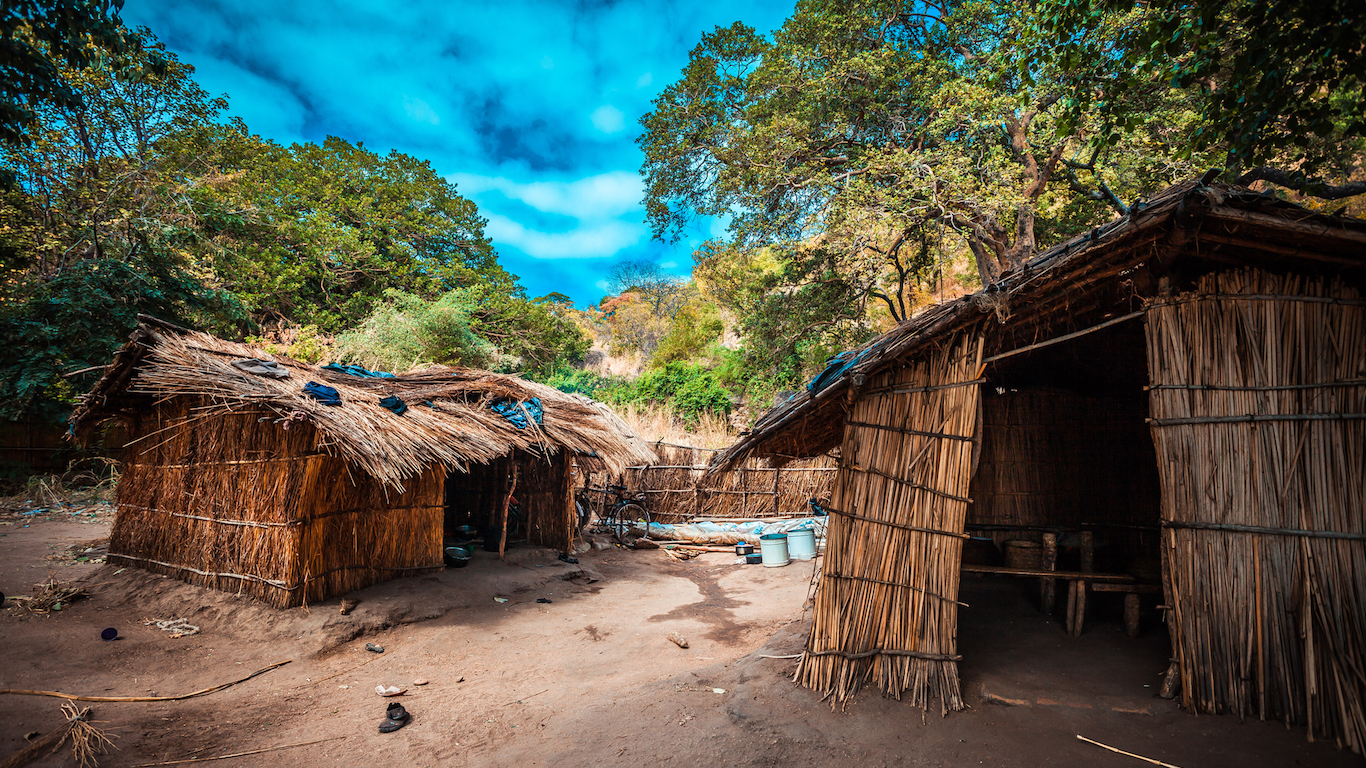
8. Malawi (tied)
> GNI per capita: $1,540
> 2020 GDP: $12.0 billion
> Life expectancy: 64.3 years
> Population: 19.1 million
Malawi’s economy struggles more than that of nearly every other country on Earth. Its GNI per capita is $1,540. For context, the U.S. GNI per capita is nearly 43 times higher. More than 82% of Malawi’s 19.1 million residents live in a rural area, often isolating them from health care and economic opportunities.
Malawi has the second highest share of people living in extreme poverty of any nation in the world, at 69.2%. The worldwide extreme poverty rate is 9.3%.
[in-text-ad-2]

8. Madagascar (tied)
> GNI per capita: $1,540
> 2020 GDP: $13.7 billion
> Life expectancy: 67.0 years
> Population: 27.7 million
Madagascar is tied for eighth poorest country in the world with another African country, Malawi. Both have a GNI per capita of $1,540. Only a handful of countries in the world have a lower GNI per capita. Less than 27% of Madagascar residents have access to electricity, and it typically takes someone over a year to gain access.
Madagascar has an unemployment rate of just 1.9%. While this would seem to be a positive economic indicator, poorer countries may have very low unemployment rates because a high share of workers are employed in agriculture, forestry, and fishing, in jobs that are frequently seasonal and typically do not pay well. In Madagascar, 24.1% of the GDP is attributed to agriculture and related fields, nearly seven times the worldwide share of economic output attributed to agriculture.
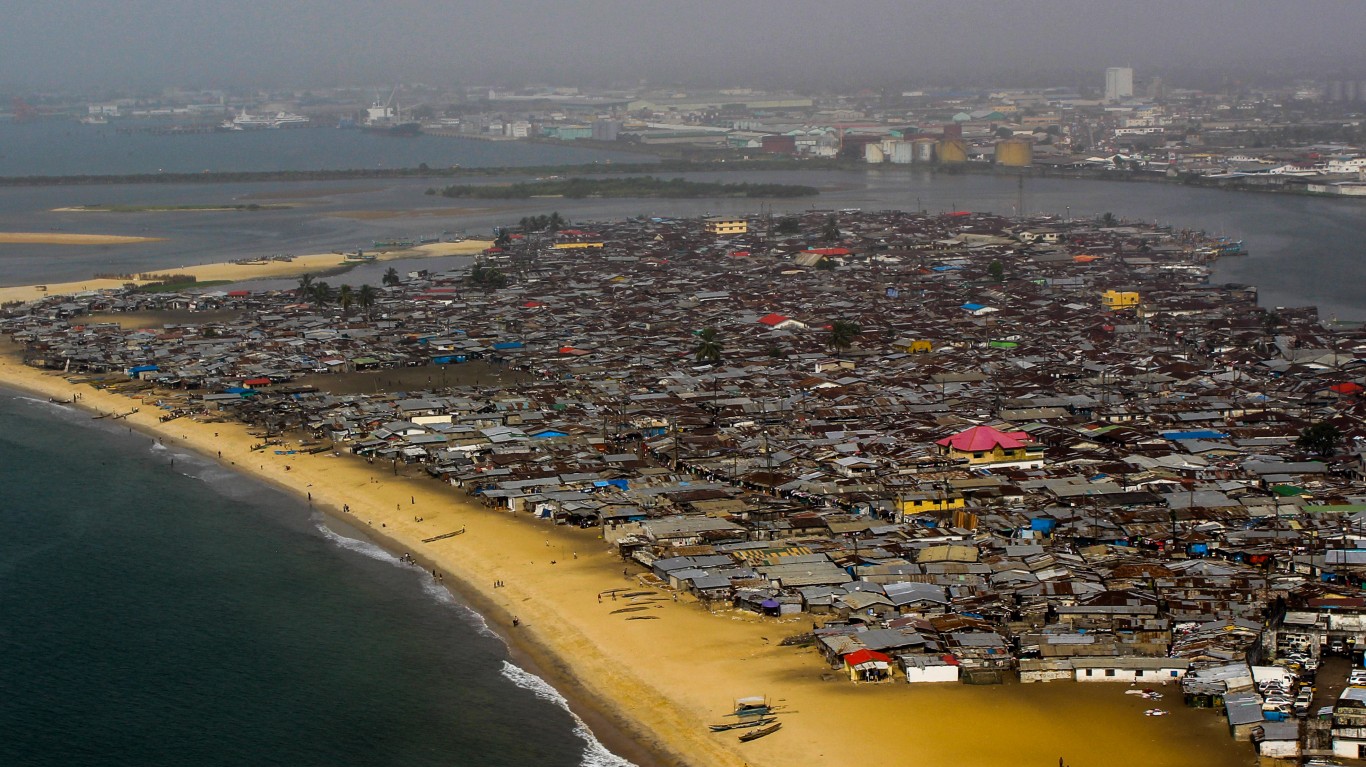
6. Liberia (tied)
> GNI per capita: $1,250
> 2020 GDP: $3.0 billion
> Life expectancy: 64.1 years
> Population: 5.1 million
Only a few countries have lower incomes than Liberia, which has a GNI per capita of $1,250. Liberia has struggled with war and political instability in recent years, though conditions appear to be improving. Former soccer star George Weah won the presidential election in 2017, marking the nation’s first democratic transfer of power in many years.
Still, Liberia has many obstacles to prosperity. Just 27.6% of the nation has access to electricity, and it takes 482 days to get electricity in the country, by far the longest wait of any country in the world. Also, nearly 52% of people 15 and older in Liberia are illiterate, compared to 13.5% of all people in the world that age.
[in-text-ad]
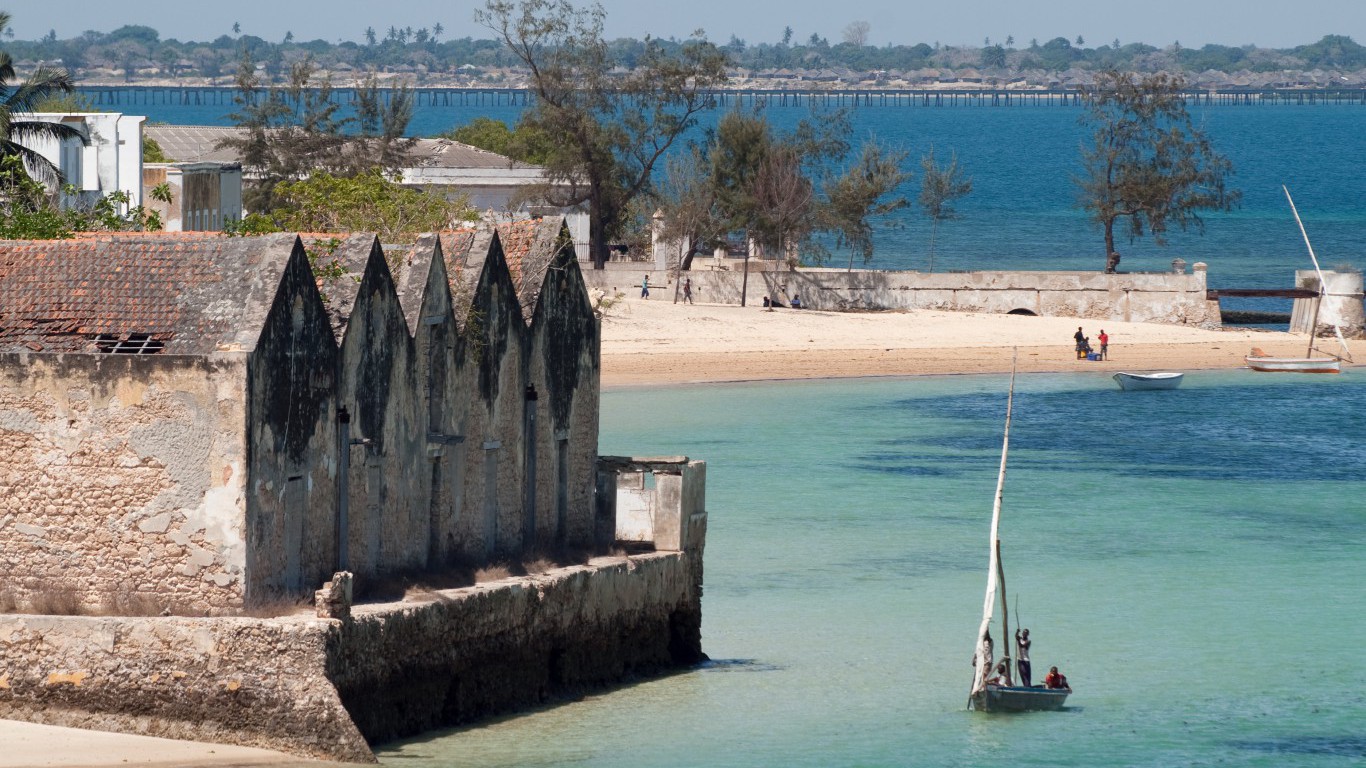
6. Mozambique (tied)
> GNI per capita: $1,250
> 2020 GDP: $14.0 billion
> Life expectancy: 60.9 years
> Population: 31.3 million
Mozambique is tied with Liberia as the sixth-poorest country in the world, with a GNI per capita of $1,250 in 2020. More than 60% of Mozambique’s population live in rural areas, and less than 30% of residents have access to electricity.
Like just three other world’s poorest countries, Mozambique, too, has a large share of its GDP coming from exports. Exports of goods and services account for 29.5% of all economic output worldwide. In Mozambique, exports account for 41% of GDP. The country’s exports totaled nearly $5.7 billion in value in 2019, and included coal briquettes, aluminum, petroleum gas, gold, tobacco, and more.

5. Niger
> GNI per capita: $1,210
> 2020 GDP: $13.7 billion
> Life expectancy: 62.4 years
> Population: 24.2 million
Niger has the fifth lowest GNI per capita in the world, at $1,210. More than 80% of Niger residents live in rural areas, and agriculture is the lifeblood of the economy — 37.8% of Niger’s GDP comes from agriculture, forestry, and fishing, compared to 3.5% of worldwide economic output. Countries that rely heavily on agriculture are typically not economically prosperous.
Limited access to health care, electricity, and economic opportunities may hamper any growth potential for Niger in the future. Just 35% of residents age 15 and older are literate, and less than 19% of all residents have access to electricity.
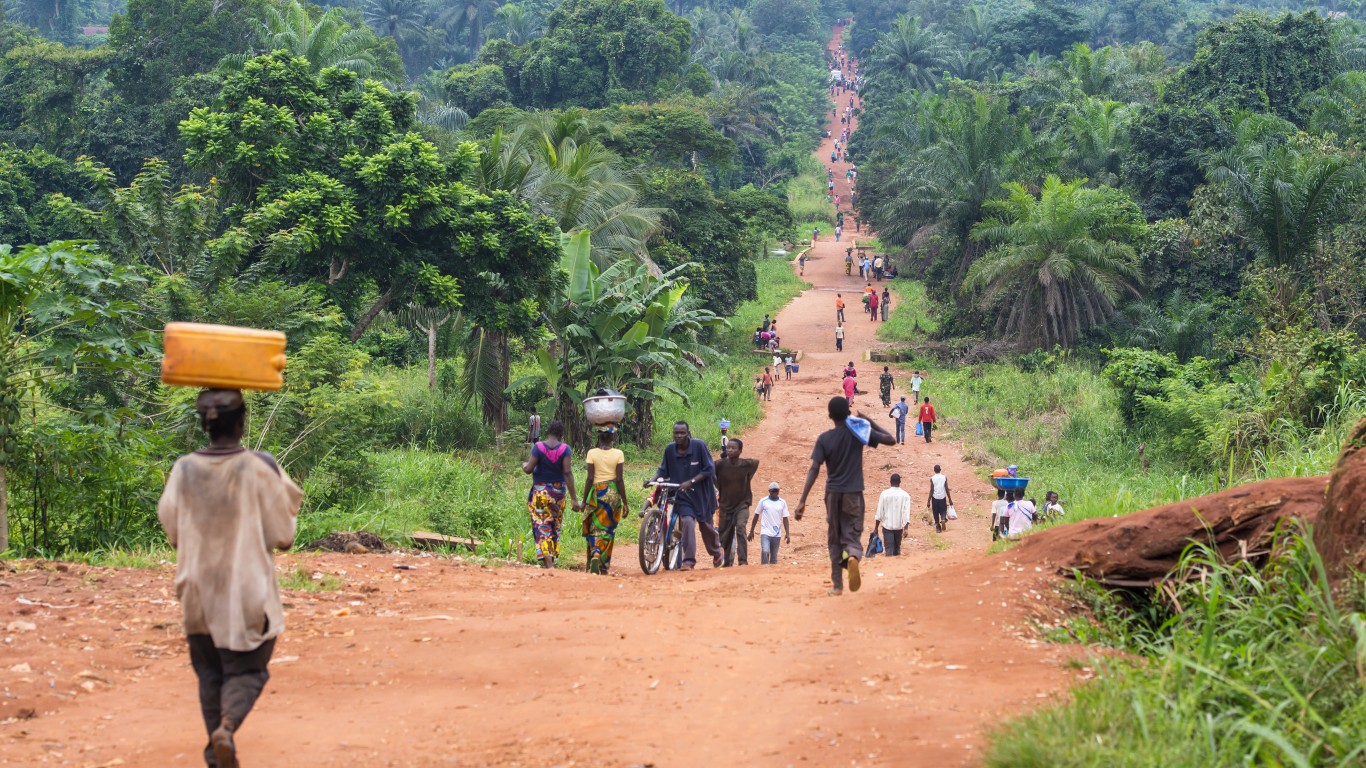
4. Democratic Republic of the Congo
> GNI per capita: $1,100
> 2020 GDP: $49.9 billion
> Life expectancy: 60.7 years
> Population: 89.6 million
The Democratic Republic of the Congo is a large country in the center of Africa. It is one of the poorest nations in the world, with a GNI per capita of just $1,100. There are likely a number of factors contributing to this low income level, including corruption. Corruption can stifle economic growth by disincentivizing innovation and decreasing efficiency. DRC ranks as one of the most corrupt countries in the world, per Transparency International.
Residents of lower-income nations may struggle to find adequate health care. The rates of child mortality, maternal mortality, and tuberculosis are all more than twice as high in the country than they are globally.
[in-text-ad-2]
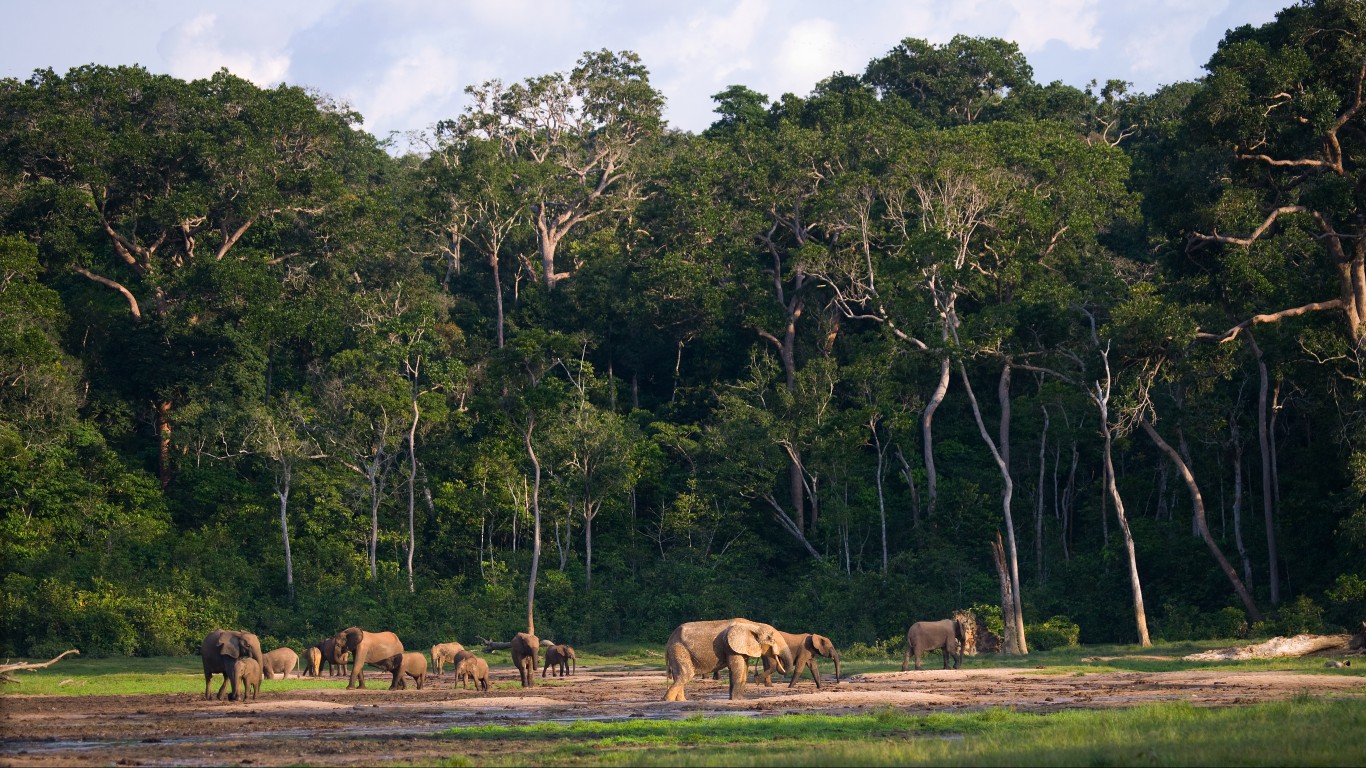
3. Central African Republic
> GNI per capita: $1,040
> 2020 GDP: $2.3 billion
> Life expectancy: 53.3 years
> Population: 4.8 million
The Central African Republic is the third poorest country in the world, with a GNI per capita of just barely over $1,000. Options for education and economic advancement are limited in the country, as just 37.4% of residents aged 15 and older are literate, and 14.3% of all residents have access to electricity.
The Central African Republic faces many of the same health challenges as other impoverished countries. It has the lowest life expectancy of any nation in the world, at 53.3 years — nearly two full decades lower than the worldwide average life expectancy. The country has among the five highest rates of child mortality, maternal mortality, and tuberculosis cases in the world as well.
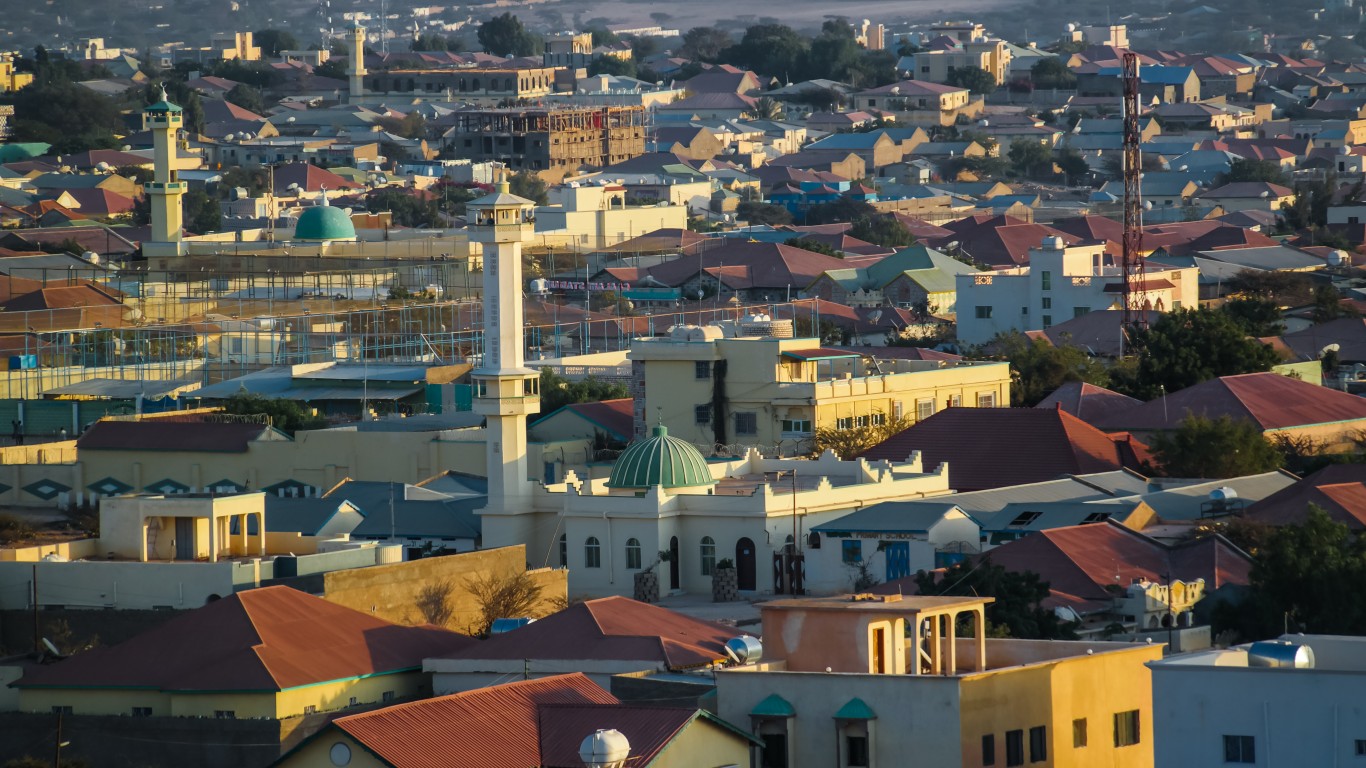
2. Somalia
> GNI per capita: $870
> 2020 GDP: $4.9 billion
> Life expectancy: 57.4 years
> Population: 15.9 million
Out of 193 nations for which there is data, Somalia is one of just two with a GNI per capita of less than $1,000, at $870. More than two-thirds of Somalia’s population live on less than $1.90 per day.
A number of factors can stand in the way of a nation’s overall economic well-being, including corruption and political disorganization — both of which are significant issues in Somalia. According to Transparency International, Somalia is the most corrupt country in the world. For decades, Somalia had no functional central government. An internationally recognized government finally took hold in 2012, though the country continues to struggle with insurgent attacks from Islamist militant groups like Al-Shabab.
[in-text-ad]

1. Burundi
> GNI per capita: $780
> 2020 GDP: $3.3 billion
> Life expectancy: 61.6 years
> Population: 11.9 million
Burundi is a landlocked country in East Africa. It is by far the poorest country in the world, with a gross national income per capita of just $780 — a fraction of the worldwide GNI per capita of $17,535.
In most of the wealthiest countries, a large percentage of the GDP comes from exports, typically well beyond the 29.5% average for all countries. Yet Burundi’s exports make up just 5.0% of its GDP, the lowest share of any country. More than 86% of Burundi’s residents live in rural areas, the second highest share among countries. Agriculture and related industries account for 28.5% of Burundi’s $3.3 billion GDP. Worldwide, agriculture makes up just 3.5% of all economic output.
Thank you for reading! Have some feedback for us?
Contact the 24/7 Wall St. editorial team.
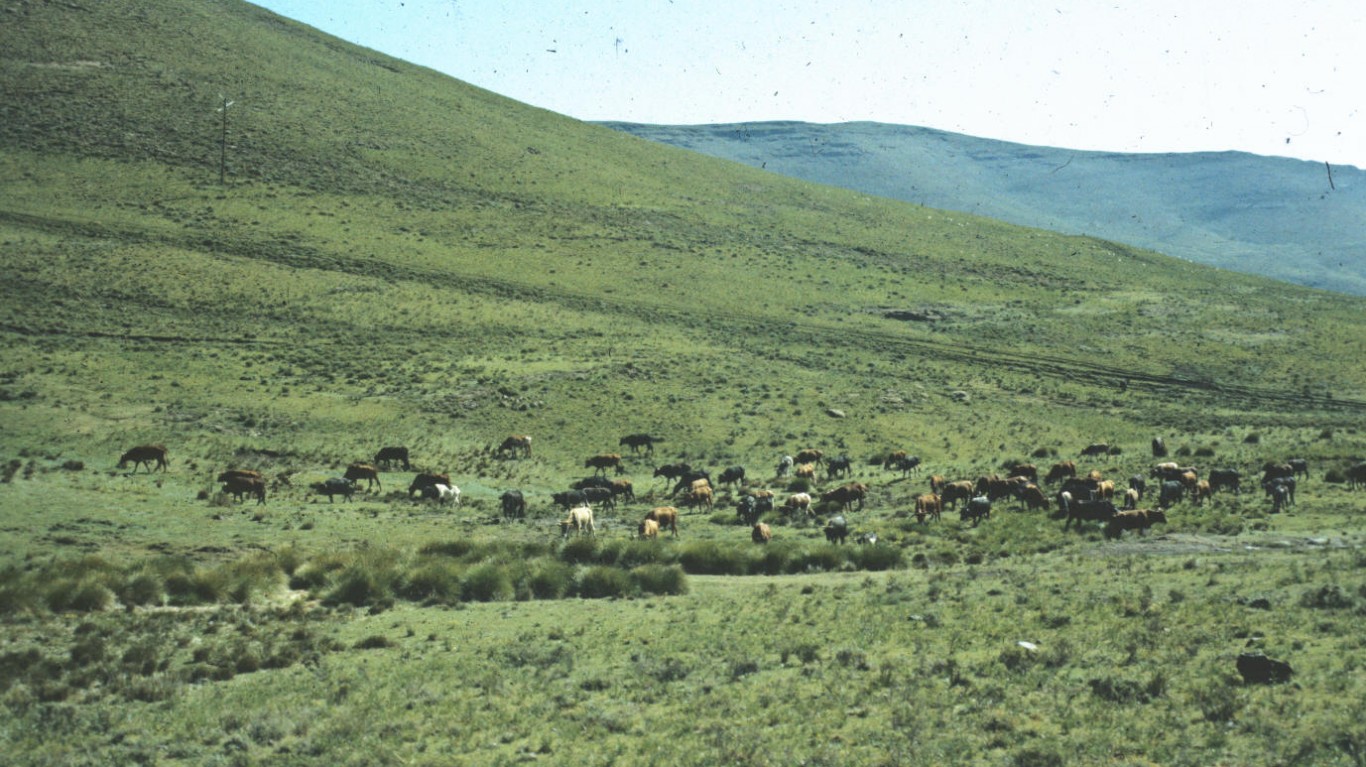
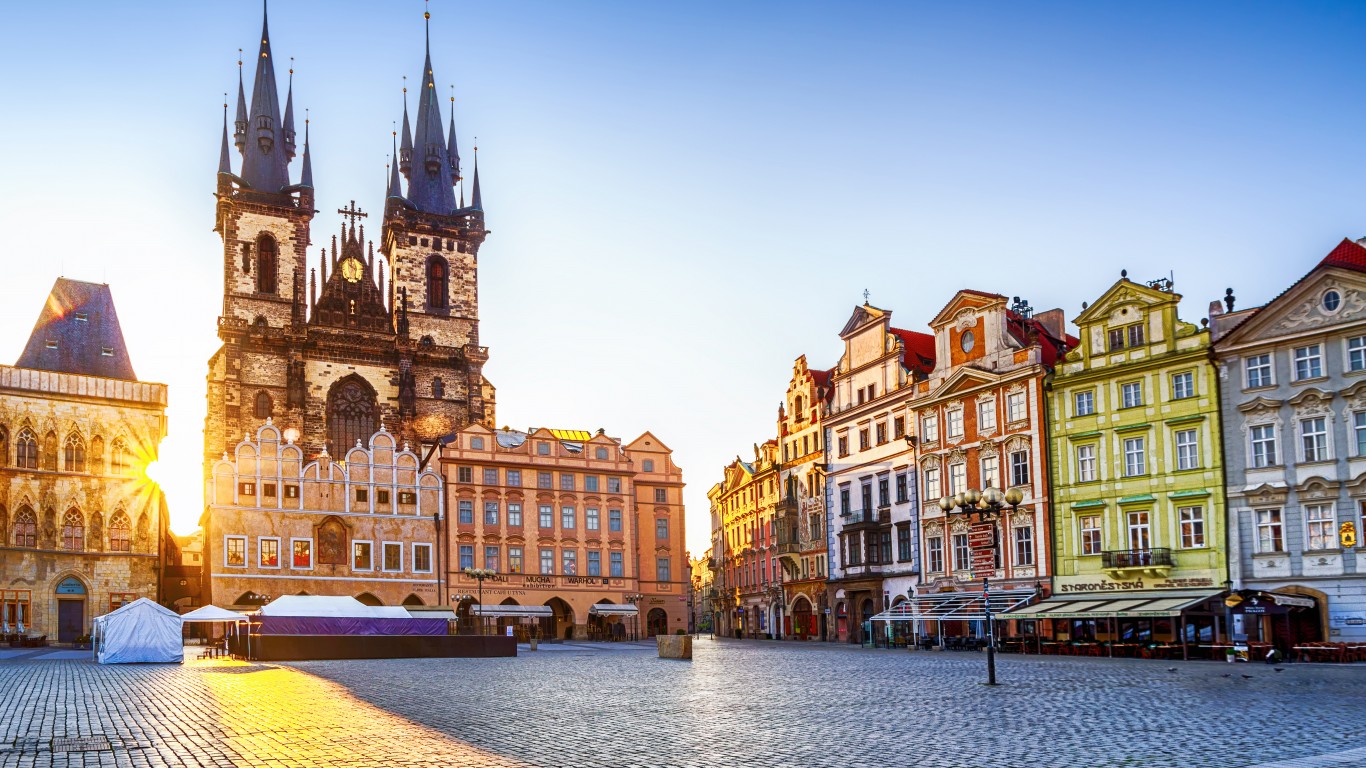 24/7 Wall St.
24/7 Wall St. 24/7 Wall St.
24/7 Wall St.

